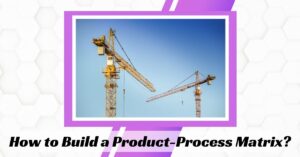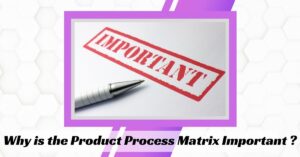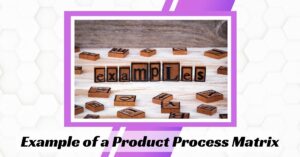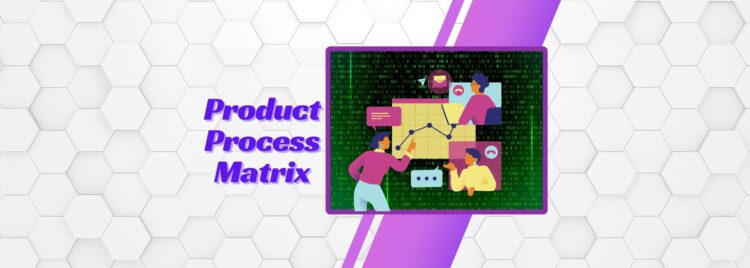Table of Contents
ToggleOverview
The Product Process Matrix is an essential tool for any organization looking to better align their product and process development for optimal performance. This framework provides an overview of the four quadrants of product process interactions and how each can be used to gain operational excellence and create a strong customer experience.
Let’s look at the structure of the product process matrix. At the core are four distinct quadrants that focus on products, processes, operational excellence, and customer experience. The product quadrant focuses on understanding various products, their market positioning, and how they perform in their category or industry. The process quadrant looks into prototyping and streamlining existing processes to identify areas of improvement. The operational excellence quadrant works to improve production cycles while optimizing performance and efficiency through data driven insights. Finally, the customer experience quadrant focuses on creating a holistic view of customer feedback to ensure that end customers have an enjoyable brand experience with your product or service.
With these four distinct quadrants in mind, business owners can be better informed about how their products and processes operate within each area. It is also possible to measure which areas need improvement more quickly by identifying trends that appear across multiple groups or segments within each quadrant. This ensures companies can create a tailored strategy for achieving operational excellence and delivering effective customer experiences over time.
By understanding how to use the Product Process Matrix as a tool for organizational growth, companies can begin to make informed decisions about their products, processes, operational practices, and customer engagement strategies. Business owners can take advantage of these best practices while developing their overall strategy to maximize efficiency and ensure long term success in all areas of business operations.
What is the Product Process Matrix?

The product process matrix merges the product life cycle, which encompasses all aspects of the product development process—from ideation to a product’s growth or decline— with the process lifecycle, the progression towards a more cost-effective and productive standardized structure.
The product process matrix was developed by Robert H. Hayes and Steven C. Wheelwright. You can find the matrix referred to as Hayes-Wheelwright Matrix. First published in the Harvard Business Review in 1979, provides organizations with a tool to estimate the progress of a product and its related processes and analyze the fit between a chosen product positioning and its related processes.
Origin of the Product Process Matrix
The Product Process Matrix, also known as the Hayes-Wheelwright Matrix, was first developed by Robert H. Hayes and Steven C. Wheelwright in 1979. They introduced the idea in articles in the Harvard Business Review, titled, ‘Link Manufacturing Process and Product Life Cycles’ and ‘The Dynamics of Process-Product Life Cycles.’
These two articles explored issues in market manufacturing processes and attempted to make use of the matrix to come up with strategic solutions. This gave organizations a tool to estimate the progress of a product along with related processes and to analyze the fit.
How to Build a Product-Process Matrix?

Creating a Product-Process matrix is a “hands-on” activity that requires a team. Project leaders should adhere to the following steps to build a PPM.
First, identify the purpose or the problem to investigate. Then, assemble the team, and remember to include frontline workers as a part of the team. Having frontline workers as part of the team is an opportunity for them to be a part of solving the problem – leveraging their experiences with the process to identify and address operational issues.
Next, define the high-level process steps involved with the business unit or with the project. The process steps should be arranged by flow order with downstream processes last. Downstream steps are those process steps that are closer to the customer. List the process steps across the top of the matrix.
Afterward, discuss and list the products, services, or flow of information that passes from process step to step. There is an opportunity to capture the roles or individuals involved in creating the products or performing the service; this information may prove useful when evaluating process bottlenecks or improvement opportunities. List each product or service down the side of the matrix.
Finally, identify and mark which products or services associate with each process step. Classify your products or services into “families” based on the similarity of process flow. You may want to include other factors as a part of the matrix such as processing time per unit, volume, or yield.
A word of caution regarding low-volume offerings: Low-volume products have a disproportionate impact on complexity. Several low-volume offerings can be grouped into a single-family class, but do not group low-volume with higher-volume offerings. Have a goal to group the products/services into 3-10 family classes.
Product-Process matrices are useful to create prior to mapping the value stream to identify representative products, services, or information to include in the process. Through the use of the matrix, take the opportunity to incorporate the voice of the customer into the process flow and the products or services. A Product-Process matrix will help a team to visualize where to focus, leading to the creation of a value stream map.
Why is the Product Process Matrix Important ?

Product leaders can use the matrix to educate teams, stakeholders, and departments within the organization on the product-process lifecycle of a project.
Using the matrix as a framework enables product leaders and managers to identify and estimate a company’s distinctive competence. (i.e., the assets and characteristics that give an organization a comparative advantage over competitors.) To better inform decisions on processes, opportunities, and investments. Distinctive competencies include cost/price, quality, flexibility, and service/time.
Here are a few of the pros and cons of using the matrix:
Advantages
- Invites broader thinking about organizational competence and competitive advantage.
- Enables greater involvement during planning, leading to better alignment among departments and the organization as a whole.
- Provides a pathway to more informed predictions and strategic responses to industry shifts and changes.
- Used to identify business opportunities and guide investment decisions.
Disadvantages
- Is static with limited product variety.
- Dimensions are too simple.
- Based on current products.
4 Process Stages of the Product Process Matrix
The Hayes-Wheelwright matrix comprises four distinct stages. In the first stage, the production process tends to be more flexible with higher associated costs. But by stage four, the production pro
cess becomes more standardized, mechanized, automated, far less flexible, and most-effective.
Here are the 4 process stages of the matrix:
1. Job Shop
Tends to be more reactive, focusing on day-to-day issues. Low volume, one-of-a-kind products are the hallmark.
“If you are an organization that falls into the job shop process, it is more than likely that you produce a variety of goods in relatively low production volumes.” (Holland)
2. Batch
The focus here tends to be on productivity enhancement and economies of scale meet standard practice. Competitive differentiation plays a central role. Organizations likely produce multiple products with a low volume.
“A batch process is one that is capable of producing more goods than a job shop, but the volume per good is still not enough to justify dedicated equipment.” (Holland)
3. Assembly Line
At this stage, there are fewer major products but higher volume.
“An assembly line process consists of highly similar goods produced in a repetitive manner. Workstations are set up so that products can pass through them in a sequential order that allows the goods to be produced in the most efficient manner.” (Holland)
4. Continuous Flow
Process and product improvements advance past industry standards and result in a sustainable competitive advantage. At this stage, there’s a high product volume along with high standardization.
“Continuous flow processes require specialized equipment in order to work continuously. This can only be possible when your range of products is extremely limited and you’re required to produce them in an extremely high volume.” (Holland)
Example of a Product Process Matrix

We shall now look at different examples of products and services and how they fall in the product-process matrix.
Law and medical clinics services are the best examples of job shops. The service provided is not only customized but also requires excellent attention to detail, along with only specific individuals being skilled enough to handle it. No two deliverables are alike, and the human factor plays a significant role.
ERP solution providers are another relevant example of job shop placement in the product-process matrix. They build customized solutions for different businesses and firms according to their needs. Within the SaaS (Software as a Service) industry, some projects might be completed in a matter of weeks, while others sometimes take up to a year.
Moving on to an example of batch production, it can be understood with the standard of a print shop where different cards and envelopes are produced with customizations in smaller batches. When talking about assembly lines, car production, and manufacturing or even fast-food chain restaurants, are the best examples of where the product is standardized and produced in high volumes.
As an example of the continuous stage in the product process framework, we can look at the petroleum or the gas industry. Stopping the process costs an enormous amount of financial loss, not only that the process is fully automated with very little to no human intervention. Labor is only used in a supervisory role to monitor the process.
Once you have your product developed you can move to the next stages:
- Product launch
- Go to market strategy
- Hire a product marketing agency
A product-process matrix is a visual tool that helps manufacturers and even service concerns alike to help determine the right product process match for their operations.
At times academia and industry experts argue on the current application of this framework. Still, we need to realize that this is the fundamental relationship between product and process. And with the evolution of product/service delivery and advancement in technology and needs, we can take on specific derivations from this matrix for practical applications.
Conclusion
When it comes to running a successful business, having an efficient product process matrix is essential. A product process matrix is a tool that allows you to analyze your product’s process and identify areas of opportunity. By utilizing this tool, you can ensure that your products are being managed effectively and with the highest customer satisfaction in mind.
In conclusion, the product process matrix is an excellent approach to understanding how your products are performing and making any necessary improvements. When analyzing the results of a product process matrix, it’s important to assess the impact on customer satisfaction and implications on business performance. This will help you understand how effective your processes are and whether or not adjustments need to be made. Additionally, consider strategies for success such as training, collaboration between teams, and better communication for more efficient processes. It’s also wise to identify potential weaknesses in advance so that you can mitigate them before they become bigger problems.
With these considerations in mind, you can develop effective plans for improvement moving forward with increased confidence in your results. Ultimately, utilizing a product process matrix will produce positive benefits for your business with improved performance and customer satisfaction down the line.
Frequently Asked Questions
What is a product-process matrix?
A product-process matrix is a tool that helps to analyze and identify the processes used in producing a certain product. It is an analytical grid which categorizes processes into four categories: core, enabling, supportive, and non-value added processes. This allows decision makers to track the various steps in manufacturing a product from beginning to end, making it easier to measure process efficiency and identify areas of improvement.
What is the product process matrix (PPM)?
The Product Process Matrix (PPM) is a tool used by product managers to identify and map the various stages in a product’s lifecycle. It provides an overview of the process steps that are required for successful product development and helps to better organize and prioritize activities relative to each stage.
What is a matrix and how does it work?
A matrix is a type of data structure used in mathematics, engineering, and computer science. It consists of rows and columns that store data values. The values can be numbers, strings, collections of objects (such as images), or other matrices. Matrices are often used to represent linear equations and transformations in space.
In the context of product process design, a matrix is a tool used to model an entire product life cycle from conception through customer delivery. By mapping the activities associated with each stage against the resources required for completion at each stage – such as time and money – project managers are able to assess the overall feasibility and cost efficiency of a certain development plan or research proposal prior to committing resources for its implementation.
What is a product family matrix?
A product family matrix is a tool used to compare and analyze product lines or categories. It provides an organized, graphical representation of the relationship between different types of products, enabling businesses to quickly identify common characteristics among them and consider their compatibility when making decisions about new or existing products. A product family matrix can include both graphical elements such as icons or images as well as textual elements such as descriptions and labels.
How to Make a Product Process Matrix?
- Gather the necessary resources, such as raw materials and information, that are needed to create the product.
- Determine the techniques and methods required for production. Consider the involvement of suppliers or partners in order to develop a comprehensive list of tasks and steps involved in producing the product, if applicable.
- Analyze each step of production and assign a specific individual or team responsible for completing it accurately and on time. Provide clear directions for all those involved in each specific task so that everyone is on the same page regarding expectations from start to finish.
- Establish deadlines for when all tasks must be completed throughout each stage of production as this will help you keep track of progress being made throughout the process matrix development phase—from conception to completion—so you can identify areas where improvement may be necessary or additional resources may need to be added/allocated in order to meet project deadlines effectively.
- Develop a cohesive timeline which includes primary processes, sub-processes, interdependent activities/action items, milestones (including any additional phases necessary regarding testing/implementation), and anticipated output based on when they should occur within the overall project roadmap timeline—this should include realistic estimates with minimal room for error created by contingencies throughout all stages of production cycle(s).
- Create an organized visual aid (such as a flowchart) representation showcasing both descriptive instructions as well as functional elements so stakeholders can easily comprehend how individual tasks interact with one another across each step within your overall product process matrix layout/structure; here’s where including visuals can really come into play!
- Fully test-run your product process matrix prior launch date(s)to ensure accuracy; do not forget to overview instructions given out at every level during this phase too determine whether everything has been followed closely according to initial plans & objectives set out initially (i e , timelines & deadline schedules).













